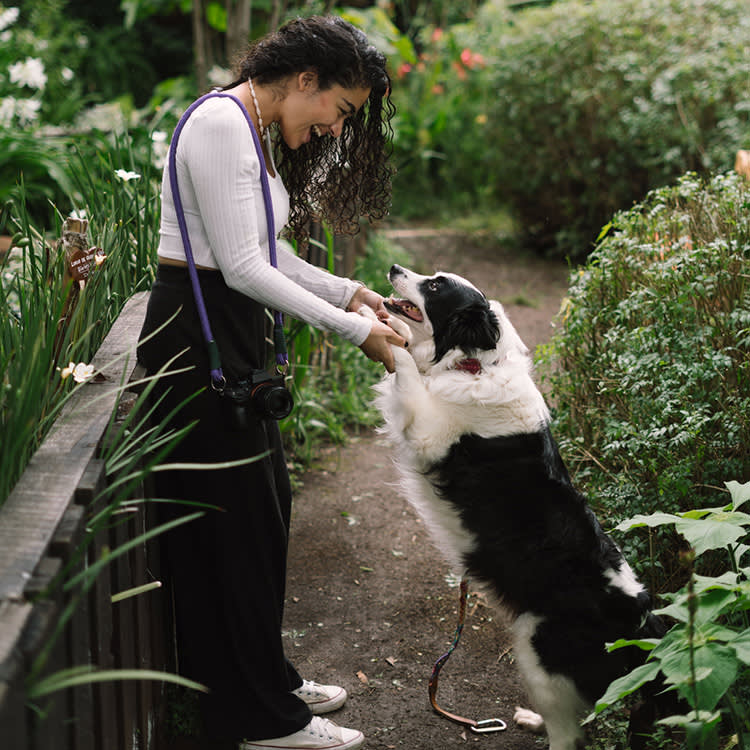Is Your Dog Bilingual?
Your dog may understand other languages better than you think, according to a new study.

Share Article
Dogs may not always seem to hear what we are saying, but they are most definitely listening. A a September 2022 study called “Language Preference in the Domestic Dog”opens in new tab in the journal Animal Cognitionopens in new tab investigated dogs’ ability to distinguish between different languages, and it turns out, they can.
The study
The researchers asked a simple question: “Can dogs tell the difference between English and Spanish?” Scientists already knew that human infants distinguish different languages based on rhythmic cues, and the same ability has also been found in cotton-top tamarins (a species of monkey weighing half a kilogram that lives in Colombia) as well as in rats. Those species do not have long-term language exposure like dogs do, making studies of dogs’ responses to different languages relatable to studies of babies. Dogs, like babies, are always hearing people talk, making dogs an ideal species for studying the role of exposure to language in both language discrimination and language preference.
The dogs in the study all lived in households in which either English or Spanish was the primary language spoken. So, each dog was used to one language, and the other language was new to them. From a linguistic perspective, the many differences between English and Spanish include differences in the length of time it takes to say each syllable. In Spanish, most syllables are of similar length but in English, unstressed syllables are shortened, while ending vowels are lengthened. These variations on syllable length lead to different rhythms in spoken language. For anyone seeking more terminology in their daily life, Spanish is a “syllable-timed” language and English is a “stress-timed” language.
All dogs, no matter which language they were used to hearing at home, were tested to assess their responses to both English and Spanish for comparison purposes. Each dog heard 22 seconds of fairy tales in each language. The fairy tales were read by a woman who is a native speaker of both English and Spanish and who was unfamiliar to the dogs. The dogs were in a sound booth while the stories were read to them, and the researchers recorded how long they oriented toward the speaker where the sound of the story was coming from.
How much do you spend on your pet per year?

Turns out, dogs are good with change
Dogs in both English-speaking homes and in Spanish-speaking homes were able to tell apart the two languages. Spanish-hearing dogs listened longer to English and English-hearing dogs listened longer to Spanish, a result that shows a novelty effect of the dogs’ language preference. In other words, they were more attentive to an unfamiliar language than the one they are used to hearing. An interest in and acceptance of novelty is part of what allows dogs to be our companions and family members. Many species are afraid of anything new, which makes them unable to cope in human society, but the domestic dog is exceptionally good at accepting new things, whether that is sounds, sights, people, or routines, when compared to other species.
Interestingly, though babies prefer their native language to an unknown language, babies have preferences for novelty over the familiar for non-linguistic stimuli. Maybe puppies would also prefer the familiar over the unfamiliar language, and that would be interesting to study in the future. (The dogs in this study were all adults with an average age of nearly five years old.) Evidence of this idea is that dogs prefer the sound of their own nameopens in new tab over the sound of another name or over the sound of their own name mispronounced. Maybe both babies and dogs prefer familiar language when it is meaningful to them as language but unfamiliar stimuli in other cases.
So, how did dogs pick up English vs. Spanish?
Researchers do not yet know whether dogs used rhythmic cues or phonological cues to tell the languages apart. They could have recognized familiar words in the stories in the language they were most familiar with, although researchers took care to avoid stories with words dogs were most likely to know such as “walk” or “treat.”
There is still so much to learn about the responses and reactions of dogs to different languages. For now, we know that we can say either “I love you” or “Te amo” to dogs, and they will know the difference, even if we are expressing exactly the same feeling.

Karen B. London, PhD, CAAB, CPDT-KA
Karen B. London is a certified applied animal behaviorist (CAAB) and certified professional dog trainer (CPDT) who specializes in working with dogs with serious behavioral issues, including aggression. She has written for a variety of magazines including The Bark, Clean Run, and the APDT Chronicle of the Dog, and has published in scientific journals including Behavioral Ecology and Sociobiology, Ethology, Ecology, and Evolution, the Journal of Insect Behavior, and Insectes Sociaux. She is the author of seven books about dog training and canine behavior, including the forthcoming My Dog's Mystery Adventure: And Other Stories From a Canine Behaviorist and Dog Trainer.
Related articles
![Woman sitting with her dog outdoors]()
How to Talk to Your Dog, According to Science
Baby talk works on puppies. As for adult dogs, that’s still up for debate.
![Young woman sitting at desk petting her senior Great Dane]()
How to Speak “Dog”
Lili Chin’s book Doggie Language illustrates how dogs communicate — beyond ear perks and tail wags.
![Dog Lays On The Ground Barking]()
Dog Speak: The Sounds of Dogs
Decoding the many sounds your pup makes.
![]()
What Are Dog Communication Buttons? And How to Use Them
Cognitive Science professor Dr. Federico Rossano on how Bunny, TikTok’s “talking” dog, is sparking change in how we communicate with our pets.
![Dog playing with orange ball toy at the beach on a sunny day]()
A Tail-Wagging Dog Isn’t Always a Happy Dog
This body language is not as simple as you probably think.







